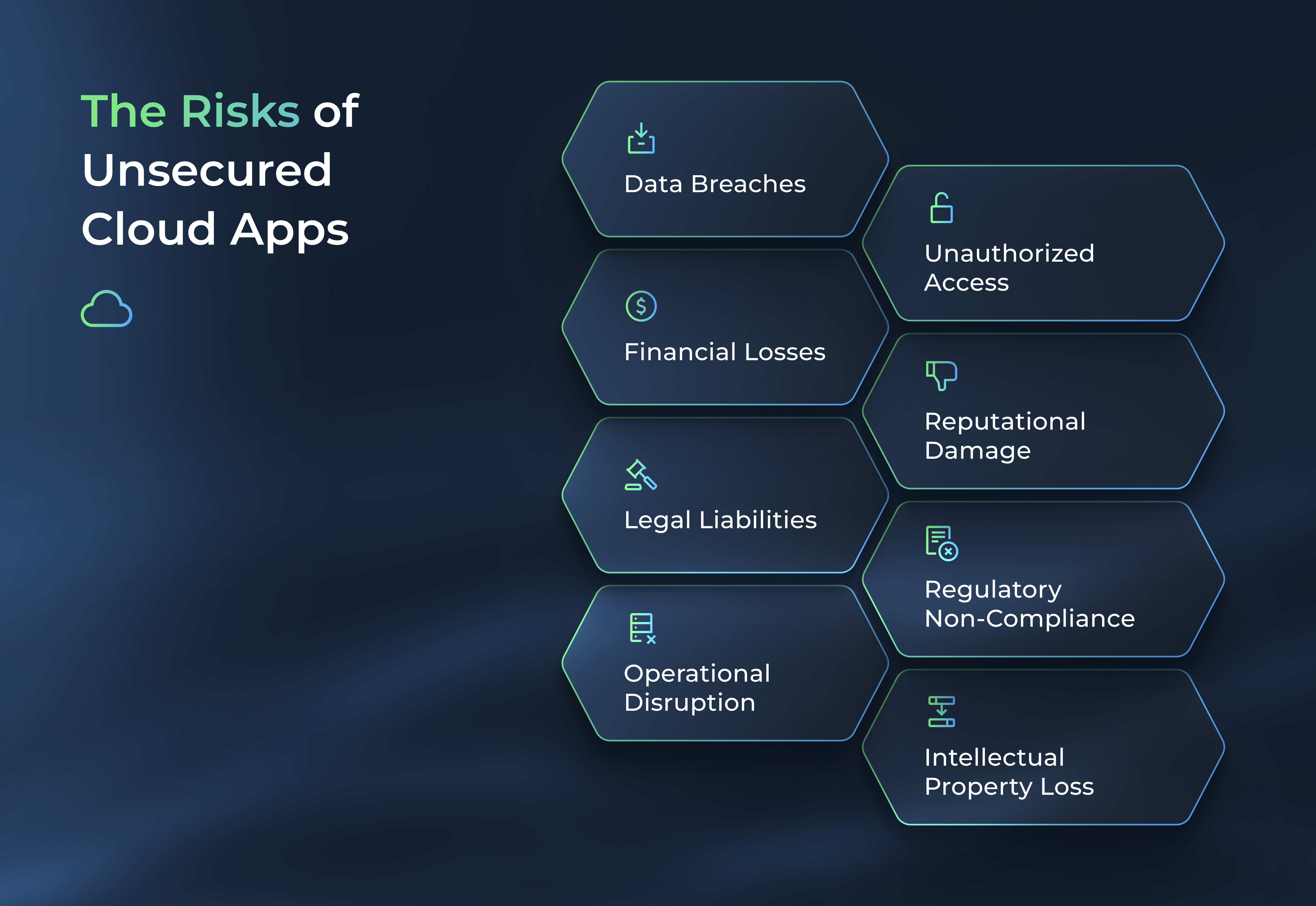Cloud-based apps have become an essential part of modern businesses. They offer numerous benefits, such as scalability, cost-effectiveness, and ease of access. However, with these advantages come potential risks that can compromise the security of your sensitive data and intellectual property. In this article, we will explore the best practices and strategies for securing your cloud-based apps, ensuring the protection of your valuable assets.
The Role of Cloud App Security
Cloud app security is crucial for the protection of your business-critical data from unauthorized access, breaches, and evolving cyber threats. We at Wesoftyou understand that the consequences of inadequate security measures can be devastating. From our experience in software development, we know that implementing robust security measures is essential to maintaining the trust of your customers and stakeholders.
When it comes to cloud app security, it is important to understand the various risks that unsecured cloud apps can pose to your business. These risks go beyond just financial losses and can have a significant impact on your overall operations.
The Risks of Unsecured Cloud Apps

Unsecured cloud apps pose significant risks to your business. They can be exploited by malicious actors to gain unauthorized access to sensitive data, resulting in financial losses, damage to your reputation, and potential legal liabilities. Breaches can also lead to regulatory non-compliance, impacting your ability to operate within specific industries.
One of the major risks of unsecured cloud apps is the potential for data breaches. These breaches can occur due to vulnerabilities in the cloud app’s security infrastructure or through targeted attacks by hackers. Once a breach occurs, sensitive information such as customer data, proprietary information, and intellectual property can be compromised. This can lead to severe financial and reputational damage for your business.
Another risk of unsecured cloud apps is the potential for unauthorized access to your business-critical data. This can occur when employees or other individuals gain access to the cloud app without proper authorization. Without robust security measures in place, it becomes easier for unauthorized individuals to access and misuse sensitive information, leading to potential financial and legal consequences.
The Importance of Cloud App Security in Business
Cloud app security plays a vital role in safeguarding your business operations. By implementing robust security measures, you can protect your company’s proprietary information, customer data, and intellectual property. This, in turn, enhances your competitiveness and builds trust among your customers and partners.
One of the key benefits of cloud app security is the ability to prevent unauthorized access to your data. With proper security measures in place, you can ensure that only authorized individuals have access to sensitive information. This helps to mitigate the risk of data breaches and unauthorized use of your business-critical data.
In addition to protecting your data, cloud app security also helps to ensure regulatory compliance. Many industries have specific regulations and standards that businesses must adhere to when it comes to data security. By implementing robust security measures, you can demonstrate your commitment to compliance and avoid potential penalties or legal issues.
Furthermore, cloud app security can also improve your overall business efficiency. With secure cloud apps, you can streamline your operations, enhance collaboration among employees, and protect your business from potential disruptions. This allows you to focus on your core competencies and drive innovation, knowing that your data is safe and secure.
In conclusion, cloud app security is not just a necessity but a strategic advantage for businesses in today’s digital landscape. By understanding the risks of unsecured cloud apps and implementing robust security measures, you can protect your business-critical data, maintain customer trust, and ensure regulatory compliance. Invest in cloud app security today and safeguard the future of your business.
Key Elements of Cloud App Security
Securing your cloud-based apps requires the implementation of various key elements. Let’s explore some of the critical components that you need to consider:
-
User Authentication: Ensures only authorized individuals access your apps and data. Utilize multi-factor authentication (MFA) for enhanced security, requiring users to provide multiple credentials.
-
Granular Access Controls: Implement role-based access controls to limit permissions based on user roles. Restrict access to sensitive information, reducing the risk of unauthorized access.
-
Data Encryption: Encrypt sensitive data during transit and at rest to prevent unauthorized access. Strong encryption algorithms safeguard information, making it indecipherable without the correct encryption key.
-
Application and Database-Level Encryption: Encrypt data at the application level for end-to-end security. Database-level encryption adds an extra layer, increasing the complexity for attackers attempting to access sensitive information.
-
Security Audits and Updates: Conduct regular vulnerability assessments and penetration testing to identify and address potential system vulnerabilities. Proactive measures help prevent security breaches and enhance overall security.
-
Regular Monitoring and Patching: Stay current with the latest security patches and updates. Timely application of patches is crucial for addressing known vulnerabilities, ensuring your cloud-based apps remain protected against evolving security risks.
In conclusion, a robust cloud app security strategy incorporates user authentication, access controls, data encryption, and regular security audits. By adopting a comprehensive approach, you can fortify your cloud-based apps, safeguarding sensitive data from unauthorized access and potential security threats.
Best Practices for Securing Cloud-Based Apps
Implementing best practices is essential for ensuring the security of your cloud-based apps. Let’s explore some recommended approaches:
Implementing Multi-Factor Authentication
Multi-factor authentication adds an extra layer of security by requiring users to provide multiple forms of identification before accessing your cloud-based apps. Enforce the use of strong passwords, biometrics, or hardware tokens to enhance authentication security.
One of the most common forms of multi-factor authentication is the use of two-factor authentication (2FA), which combines something the user knows (like a password) with something the user has (like a smartphone or hardware token). This approach significantly reduces the risk of unauthorized access, as even if an attacker manages to obtain the user’s password, they would still need physical possession of the second factor to gain entry.
Another emerging form of multi-factor authentication is biometric authentication, which uses unique physical or behavioral characteristics, such as fingerprints, facial recognition, or voice recognition, to verify a user’s identity. Biometrics provide an additional layer of security, as they are difficult to replicate or forge.
Utilizing Advanced Encryption Techniques
Advanced encryption techniques, such as asymmetric encryption and hashing algorithms, can provide robust protection for your sensitive data. Implement encryption at various levels, including in transit, at rest, and in the application itself, to ensure comprehensive data security.
Asymmetric encryption, also known as public-key encryption, uses a pair of keys – a public key for encryption and a private key for decryption. This ensures that only authorized parties can decrypt the data, even if the encrypted data is intercepted by an attacker.
Hashing algorithms, on the other hand, convert data into a fixed-length string of characters, called a hash value. This hash value is unique to the input data and cannot be reversed to obtain the original data. By storing only the hash values of sensitive data, you can ensure that even if the data is compromised, it cannot be easily deciphered.
Regularly Updating and Patching Apps
Regularly updating and patching your cloud-based apps is crucial for mitigating security risks. Keep track of the latest security updates and patches provided by the app vendor and promptly apply them to your environment. Additionally, regularly review and update your app configurations to ensure optimal security settings.
Software updates and patches often include security fixes that address known vulnerabilities. By promptly applying these updates, you can protect your cloud-based apps from potential exploits that attackers may attempt to leverage.
Furthermore, it is important to regularly review and update your app configurations to ensure that security settings are aligned with best practices. This includes enabling features like secure communication protocols, access controls, and logging mechanisms. Regularly auditing and monitoring these configurations can help identify and address any potential security gaps.
Strategies for Enhancing Cloud App Security
Enhancing cloud application security requires a proactive approach. Consider the following strategies:
Cloud computing has revolutionized the way businesses operate, providing flexibility, scalability, and cost-efficiency. However, with this convenience comes the need for robust security measures to protect sensitive data and ensure the integrity of cloud-based applications. In this article, we will explore three key strategies for enhancing cloud app security.
Adopting a Zero Trust Security Model
A Zero Trust security model treats every user, device, and connection as potentially untrusted, regardless of its network location. This approach challenges the traditional perimeter-based security model by assuming that threats can originate from both internal and external sources. By implementing granular access controls, continuous authentication, and behavior monitoring, organizations can mitigate the risks associated with insider threats and compromised credentials.
Granular access controls involve defining specific permissions and privileges for each user or device, ensuring that they only have access to the resources they need. This minimizes the potential damage that can be caused by a compromised account. Continuous authentication goes beyond traditional username and password authentication by incorporating additional factors such as biometrics or multi-factor authentication. This adds an extra layer of security, making it more difficult for unauthorized individuals to gain access to sensitive data.
Behavior monitoring involves analyzing user behavior and network traffic patterns to identify any suspicious activities or deviations from normal behavior. By leveraging advanced analytics and machine learning algorithms, organizations can detect potential security incidents in real-time and take immediate action to mitigate the risks.
Leveraging AI and Machine Learning for Security
The application of AI and machine learning can significantly enhance cloud application security. These technologies enable real-time threat detection, anomaly detection, and predictive analysis, allowing organizations to identify and respond to potential security incidents more effectively.
Real-time threat detection involves continuously monitoring network traffic, user activities, and system logs to identify any signs of malicious behavior. By analyzing patterns and correlating data from various sources, AI-powered systems can quickly identify and block potential threats before they can cause any harm.
Anomaly detection focuses on identifying deviations from normal behavior. By establishing baselines and using machine learning algorithms, organizations can detect unusual activities that may indicate a security breach. This proactive approach allows for early detection and response, minimizing the potential impact of a security incident.
Predictive analysis leverages historical data and machine learning algorithms to anticipate potential security threats. By analyzing past incidents and identifying common patterns, organizations can proactively implement preventive measures to mitigate the risks. This proactive approach is particularly effective in identifying emerging threats and vulnerabilities.
Incorporating Security in the App Development Process
Integrating security practices into the app development process is essential for reducing vulnerabilities and ensuring the overall security of your cloud-based apps. By considering security from the initial stages of development, organizations can identify and fix security flaws before deployment, minimizing the potential risks.
Secure coding practices involve following established guidelines and best practices to write secure and resilient code. This includes input validation, proper error handling, and secure storage of sensitive data. By adhering to these practices, developers can reduce the likelihood of introducing vulnerabilities into the application.
Thorough code reviews involve conducting comprehensive reviews of the application’s source code to identify any potential security flaws. This process involves both automated tools and manual inspection by experienced developers. By identifying and fixing security issues early in the development cycle, organizations can prevent these vulnerabilities from being exploited in the production environment.
Rigorous testing is crucial for ensuring the security of cloud-based apps. This includes both functional testing to ensure that the application meets the desired requirements and security testing to identify any potential vulnerabilities. Security testing techniques such as penetration testing and vulnerability scanning can help organizations identify and address security weaknesses before the application is deployed.
In conclusion, enhancing cloud app security requires a multi-faceted approach. By adopting a Zero Trust security model, leveraging AI and machine learning for security, and incorporating security practices in the app development process, organizations can significantly enhance the security of their cloud-based applications. These strategies provide a strong foundation for protecting sensitive data, mitigating risks, and ensuring the overall integrity of cloud app environments.
Challenges in Cloud App Security
Securing cloud-based apps comes with its own set of challenges. Let’s explore some common obstacles and how to address them:
Cyber Threats
Cyber threats are constantly evolving, making it challenging to stay ahead of the game. Stay informed about the latest security trends, invest in robust threat intelligence solutions, and collaborate with reputable security vendors to ensure your apps are protected against emerging threats.
In today’s digital landscape, cybercriminals are becoming increasingly sophisticated in their attack methods. They constantly adapt and develop new techniques to exploit vulnerabilities in cloud-based applications. To effectively combat these evolving cyber threats, organizations must stay proactive and vigilant.
One way to stay ahead is to stay informed about the latest security trends and technologies. By keeping up with industry news and attending security conferences, organizations can gain valuable insights into emerging threats and effective countermeasures.
Investing in robust threat intelligence solutions is another crucial step in securing cloud-based apps. These solutions provide real-time information about potential threats, allowing organizations to proactively identify and mitigate risks before they can cause any harm.
Collaborating with reputable security vendors is also essential. By partnering with experienced professionals, organizations can leverage their expertise and benefit from advanced security solutions tailored to their specific needs.
Compliance and Regulatory Requirements
Compliance with industry regulations and data privacy laws is crucial for business operations. Understand the regulatory landscape relevant to your industry and implement security measures that align with compliance requirements. Regularly monitor and audit your cloud-based apps to ensure ongoing compliance.
In today’s data-driven world, businesses must comply with various industry regulations and data privacy laws to protect sensitive information and maintain customer trust. Failure to meet these requirements can result in severe consequences, including legal penalties and reputational damage.
Understanding the regulatory landscape relevant to your industry is the first step in managing compliance and regulatory requirements. Stay updated on the latest regulations and guidelines issued by regulatory bodies such as GDPR, HIPAA, and PCI DSS.
Implementing security measures that align with compliance requirements is crucial. This includes encrypting sensitive data, implementing access controls, and regularly patching and updating software to address known vulnerabilities.
Regular monitoring and auditing of cloud-based apps are essential to ensure ongoing compliance. Conduct regular security assessments and penetration testing to identify any potential weaknesses or vulnerabilities in your applications. By proactively addressing these issues, organizations can minimize the risk of non-compliance.
Security Concerns in Multi-Cloud Environments
Many businesses leverage multiple cloud providers to achieve scalability and redundancy. However, managing security across diverse cloud environments can be complex. Implement centralized security controls, utilize security automation tools, and enforce consistent security policies across all cloud providers to mitigate the risks associated with multi-cloud environments.
The adoption of multi-cloud environments has become increasingly popular among businesses seeking to leverage the benefits of different cloud providers. However, managing security in such environments can be challenging due to the complexity and diversity of cloud platforms.
Implementing centralized security controls is crucial in addressing security concerns in multi-cloud environments. This allows organizations to have a unified view of their security posture and enforce consistent security policies across all cloud providers. By centralizing security controls, organizations can effectively manage access controls, monitor user activity, and detect and respond to security incidents.
Utilizing security automation tools can also help in managing security in multi-cloud environments. These tools automate security tasks, such as vulnerability scanning and configuration management, reducing the manual effort required to ensure consistent security across multiple cloud platforms.
Enforcing consistent security policies across all cloud providers is essential to mitigate the risks associated with multi-cloud environments. Organizations should establish a set of security policies that align with their overall security objectives and ensure these policies are consistently applied across all cloud platforms.
In conclusion, securing cloud-based apps requires organizations to stay ahead of evolving cyber threats, manage compliance and regulatory requirements, and address security concerns in multi-cloud environments. By implementing the right strategies and leveraging advanced security solutions, organizations can effectively protect their cloud-based apps and data from potential threats.
Future Trends in Cloud App Security
As technology advances, new trends in cloud application security emerge. Let’s explore some future possibilities:
Quantum Computing on Security
Quantum computing has the potential to revolutionize many aspects of technology, including security. Quantum-resistant encryption algorithms are being developed to protect against the encryption-breaking capabilities of quantum computers. Stay informed about these advancements to adapt your security measures accordingly.
Blockchain in Cloud App Security
Blockchain technology offers decentralized and tamper-proof record-keeping, which can enhance the security of cloud-based apps. Implementing blockchain-based authentication and data integrity mechanisms can provide additional layers of trust and transparency to your applications.
Biometric Security in Cloud Apps
Biometric authentication, such as fingerprint or facial recognition, is gaining popularity due to its convenience and security. Integrating biometric security measures into your cloud-based apps can provide a highly secure and user-friendly authentication experience.
In conclusion, securing your cloud-based apps is essential for protecting your valuable assets and maintaining the trust of your customers. By incorporating best practices, leveraging advanced techniques, and staying updated with emerging trends, you can ensure the utmost cloud application security. Remember, at Wesoftyou, we have the expertise and proven track record in software development to help you implement robust security measures for your cloud-based apps. Contact us for a free consultation or project estimation and let us assist you in securing your cloud-based apps.
FAQ
Cloud app security is important to protect your business-critical data, intellectual property, and maintain the trust of your customers and stakeholders. Ensuring robust security measures can prevent unauthorized access, data breaches, and potential legal liabilities.
Key elements of cloud app security include user authentication and access control, data encryption and protection, and regular security audits and updates.
You can enhance the security of your cloud-based apps by implementing multi-factor authentication, utilizing advanced encryption techniques, and regularly updating and patching your apps. Additionally, adopting a Zero Trust security model and leveraging AI and machine learning can further enhance your app security.





















